Our story begins in France, with an imperial decree regulating water supplies to towns and cities, before spreading to all corners of the globe with the development of ambitious solutions to protect our environment and our resources, and including our merger with Suez and the creation of the global champion of ecological transformation.
Find out more about our fascinating story, one that reflects the changes, large and small, in society over many decades.
1. Hand in hand with social change in the 19th century
Let us take a trip back in time to the 19th century, when industrialization in Europe meant that people were increasingly moving to urban centers. In 1800, 20 million Europeans lived in towns with a population of over 5,000. A century later, they numbered closer to 150 million. Towns and cities had to adapt. Water, waste, energy, transportation, everything had to be rethought. These challenges led to the emergence of new specialties that, once combined, pointed the way to the Veolia of today: a group that exists to serve human progress, capable of supplying real-world solutions to the challenges of ecological transformation.
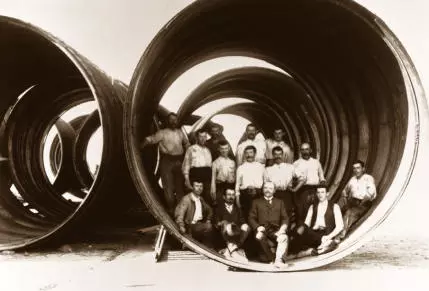
Supplying water to towns and cities
Did you know that in 18th century Paris you would see water-carriers who delivered water around the capital? It was only in the 19th century that new techniques made it possible to run a water supply direct to individual lodgings. Big cities like Paris, Lyon, Marseille and Toulouse were all looking for ways to update their water supply systems.
On December 14, 1853, Napoléon III authorized the creation of the Compagnie Générale des Eaux. It won its first public service water distribution concession in Lyon. Other French cities followed, including Nantes, Nice and Paris its suburbs. 1880 was the year the Compagnie first established a toehold outside France. This signaled the beginning of its international expansion, first in Venice, then Constantinople and Porto. In 1884 in Reims, France, it expanded its activities to include treating wastewater for the first time.
Fighting urban squalor
The 19th century saw the dawn of the so-called hygienist movement. In attempting to stem epidemics and fight the squalor that characterized life in many towns and cities, hygienists faced a new challenge: how to manage the ever growing volume of waste.
It was an era when rag-pickers combed the streets to recover waste and garbage. In Rouen, France, the Soulier brothers established their company in 1870. That same year, François Grandjouan was tasked by the city of Nantes to “clear the streets of sewage and filth and convert it into manure.” Remember these names, as we will meet them again a century later.
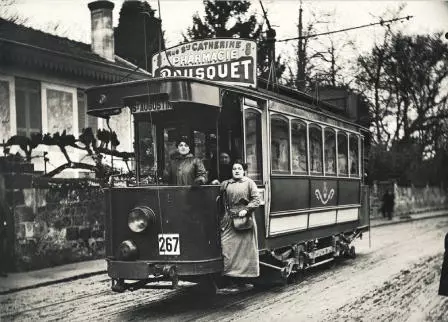
Making travel in the city easier
Still in the 19th century, public transportation was evolving: the omnibus slowly gave way to the tram, faster and more comfortable. This in turn encouraged the development of mechanically powered traction, first with steam, then compressed air, and finally electricity. In 1875, the Compagnie Générale Française de Tramways began operating its first lines in Le Havre, Nancy, Marseille and Bordeaux.
Several decades later, in 1912, as private car ownership was growing, Charles Blum founded the Compagnie Générale d’Entreprises Automobiles, initially with the aim of running a fleet of commercial vehicles. In 1919 it entered the market for household waste collection in Paris.
Saving energy
Let us now skip forward a couple of decades, to the Aisne department in north-eastern France. In 1937, the hospital in Villiers-Saint-Denis asked a company called Chauffage Service to manage and maintain its heating system, and provide guaranteed temperatures. This was the very first energy performance contract.
Combining a range of expertise
But let us return to the subject of water. In 1953, the Compagnie Générale des Eaux celebrated its centenary. With a 10,000-kilometer network, it provided drinking water to eight million people in France alone.
Five years later, it won a water services maintenance contract covering almost all the American NATO military bases in France. During this period, the Compagnie also started to expand its range of expertise, offering new maintenance and energy services.
This was the beginning of what today we call integrated facilities management services. This approach allows industrial customers to benefit from a very wide range of in-house services, from utility management — water, electricity, steam or gas — to soft services such as building cleaning and waste management
2. Creating solutions to the problems of the second half of the 20th century
In 1973, the global economy was confronted with an unparalleled crisis: a fourfold rise in the price of oil, from $2.59 to $11.65 a barrel. This forced people to look for new ways to save energy.
The Chauffage Service company, which had begun offering the first energy performance contracts a few years earlier, merged with the Compagnie Générale de Chauffe. The merged company offered innovative services in response to the oil crisis, such as geothermal engineering using heat from the earth, and techniques for recovering lost energy.
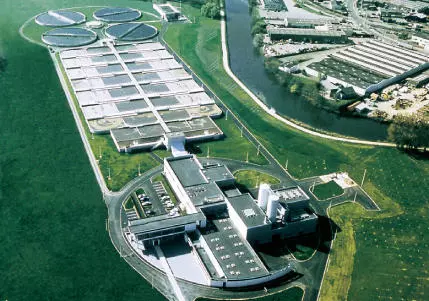
At the same time, faced with the need to process and recover hazardous waste, the Compagnie Générale des Eaux set up SARPI. Today, SARPI is the leading European specialist in its field and has processed 4.3 million metric tons of hazardous waste on behalf of over 10,000 industrial customers.
The future Veolia begins to take shape
During the 1980s, the Compagnie Générale des Eaux absorbed, among others, the companies mentioned earlier:
- Grandjouan and Soulier, as well as the Compagnie Générale d’Entreprises Automobiles, specialists in waste collection;
- as well as the Compagnie Générale de Chauffe and Esys-Montenay, another company from the same sector. In 1998, these two merged to create Dalkia, part of EDF Group since 2014.
Water, waste, energy: you will have probably spotted our three historical business activities, which continue to provide us with the tools we need to tackle the major ecological challenges facing today’s world.
3. Setting ourselves an ambitious goal
In 1998, the Compagnie Générale des Eaux was renamed Vivendi. The following year saw the creation of Vivendi Environnement, grouping together all the environmental services activities: water, cleaning, energy services and transport. Vivendi Environnement was floated on the Paris stock market in July 2000, joining the CAC 20 in August 2001.

In 2003, Vivendi Environnement was renamed Veolia Environnement. Two years later, the Veolia brand was applied to all the group’s activities: Veolia Water, Veolia Environmental Services, Veolia Energy and Veolia Transport.
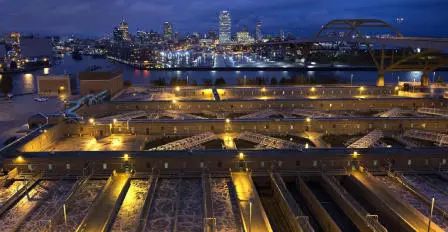
Resourcing the world
In 2009, Antoine Frérot took over at the head of the Group, with the stated aim of “becoming the industry standard for environmental solutions.” In December 2011, Veolia Environnement refocused its portfolio of activities and businesses, progressively withdrawing from its transportation businesses. This was the dawn of a new-look Veolia.
The transformed group was now ready to start Resourcing the world, its signature slogan since 2014.
The following year, against a backdrop of the COP21 Paris Climate Conference, Veolia renewed its commitment to fighting the climate crisis. As part of its drive to cut greenhouse gas emissions, the Group focused extensively on the circular economy, implementation of the polluter pays principle, and working to cut methane emissions.
The 2010s also saw a number of major projects delivered around the world: inauguration of the world’s largest sludge treatment and recovery plant in Hong Kong, development of renewable biomass energy in Hungary, and the creation of Graphitech, in partnership with EDF, specializing in dismantling nuclear reactors.
4. Becoming the leader of ecological transformation
In April 2019, Veolia became one of the first French businesses to define its purpose. This placed a determination to reconcile human advancement and protecting the environment firmly at the center of Veolia’s mission, seeking to create a better and more sustainable future for one and all.
Putting it into practice, the Impact 2023 strategic plan focused on the central challenges: fighting the climate crisis, treating pollution, optimizing resources and improving quality of life.
To meet these challenges, and in the face of the climate crisis, in May 2021 Veolia signed a historic deal sealing its merger with Suez, the world’s largest privately owned water company and a leading player in waste recycling and recovery. In January 2022, the first ex-Suez employees began to join Veolia’s teams and in July 2022 the Group turned another new page in its history as Estelle Brachlianoff replaced Antoine Frérot as Chief Executive Officer of Veolia.
To be the global leader of ecological transformation is a huge responsibility,” she emphasized in her introductory video. “You can count on me to stand alongside you, as we meet the major challenges of our age together.
Veolia is ready to shape the future. A sustainable and exciting future where we will continue to serve humanity’s vital needs, while also protecting the environment. Always with the same determination.
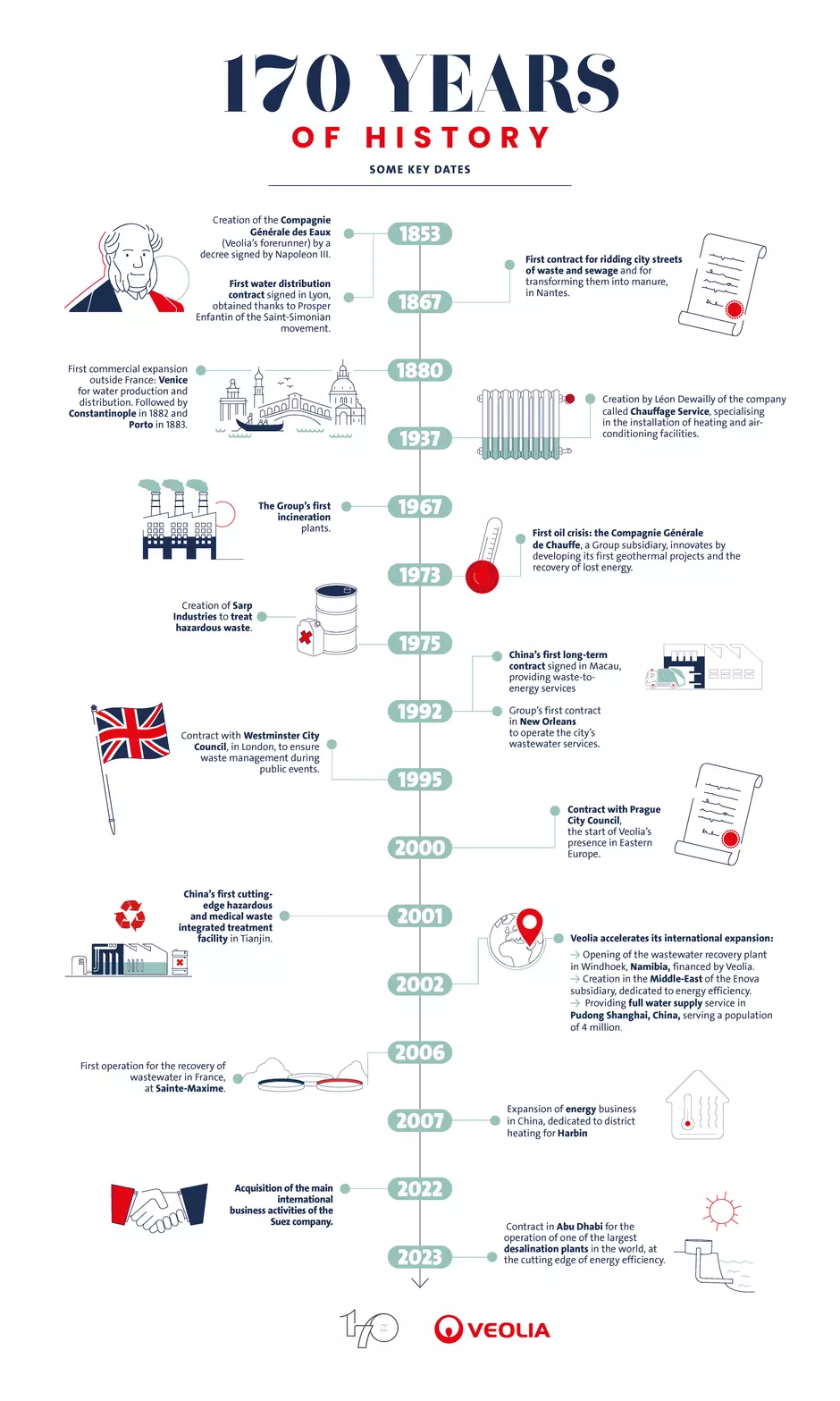
Watch the video
looking at the key dates in our history


